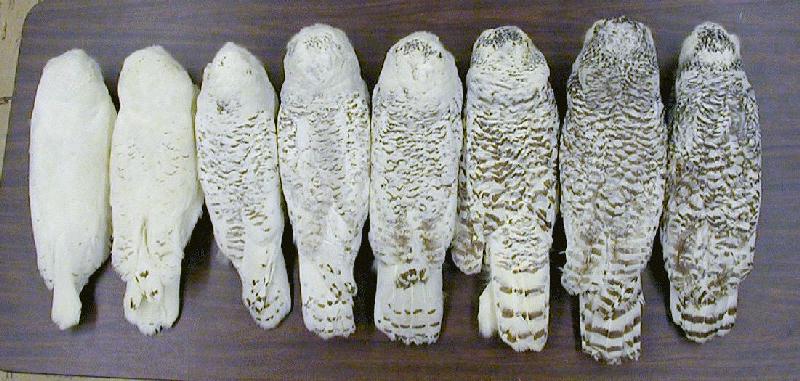
Snowy Owls (Nyctea scandiaca): some recent visitors and thoughts on aging and sexing.
Specimen photos © Cornell University Museum of Vertebrates.
All other photos © Kevin J. McGowan.
It appears that Snowy Owls can be aged and sexed fairly reliably in the hand using a number of feather shape and color characters (see Pyle, P. 1997. Identification Guide to North American Birds. Part I. Slate Creek Press, Bolinas, CA); the utility of these characters in field ID is much more limited. Although I doubt anyone could definitely assign "second year female" status to a bird not in the hand, owls encountered in the field can probably be put in a couple of general categories (adult male, first year or immature male, female). Below are some photos of specimens from the Cornell University Museum of Vertebrates collection that illustrate these characters.
The following series of 8 owls was arranged from lightest individual on the left to darkest on the right. It is a nicely graded series, but I think you can see a distinct change between the 5th and 6th individuals, with the three on the farthest right being markedly darker and with larger, darker spots on the feathers. This difference represents the break between the sexes: the 5 on the left are all males, the three on the right are females. Note the wider and darker bars on the back, nape, and especially the tails of the females.

The following picture shows the same specimens in the same order (5 males on left, 3 females on right). Again note the more extensive and darker marks on the feathers of the females.
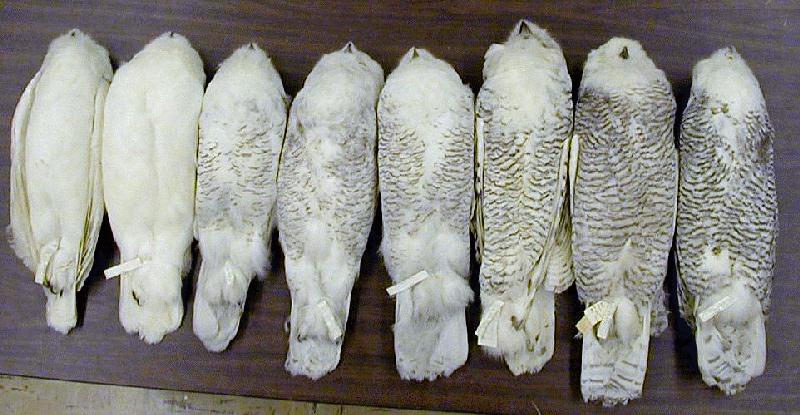
The most key points to look at for determining sex are probably the extent of the white bib (larger on males; but extent is dependant upon the position of the head, and as can be seen by the leftmost female, it can be rather large on females), the darkness at the nape of the neck (dark in females, mostly white in males), and the barring of the tail (some complete, or nearly complete bars on females; males with mostly broken bars, or nearly complete at best).
Here are closeups of the two most intermediate birds to illustrate the points (male on left, female on right).
Note the wider, darker bars on the back, and especially the nape.
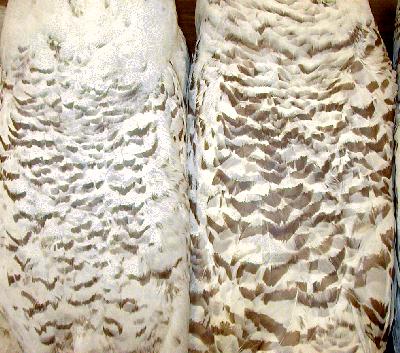
Note that even though the male (left) has nearly complete bars on the tail feathers they are thinner and less complete than the female (right). Also interesting is the fact that the wing tips of the male have thick dark bars; the corresponding feathers on the female are not visible because of the preparation.
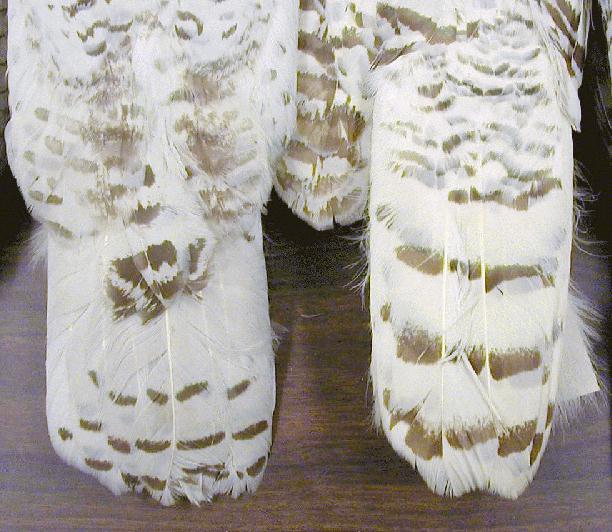
I had thought that color of the dark markings would distinguish the two. Females always seemed marked with dark brown to nearly black, while males were much lighter and more distinctly brown. Upon examination, however, this difference was less detectable than I thought it would be. Also, males do have the darker brown on the back. Still, any Snowy that looks nearly black and white is probably a female.

So, what were the local owls?
Here are some photos Jay and I took recently (with an Olympus D-450 digital camera using our Swarovski HD-80 spotting scope as a super telephoto lens). All photos © Kevin J. McGowan.
The first is a bird from the Savannah Mucklands, Wayne Co, NY, 24 November 2000. This first owl shows extensive dark markings, and little bib in the first photo; probably a female.

We were able to maneuver around and get closer pictures of the same owl that confirm that it was a female: look at the extensive very wide and dark markings.
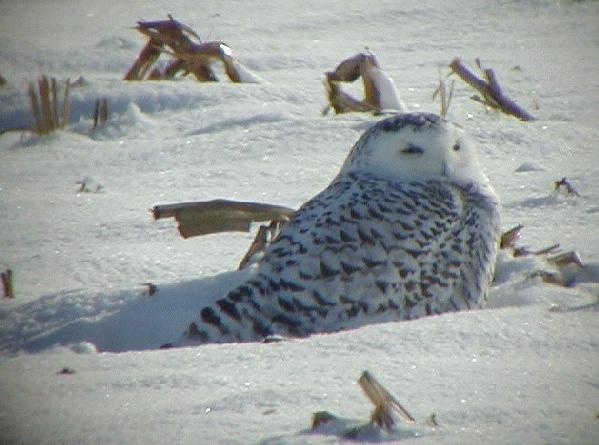
Note also the dark nape in this photo.
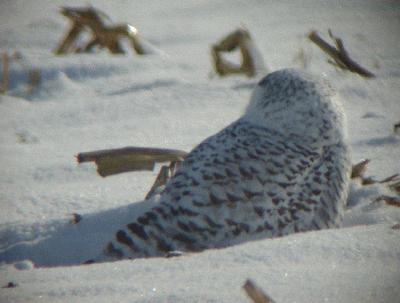
We observed a second Snowy Owl at the Mucklands on 24 November 2000, but couldn't get very close (about a quarter mile at best). The following photo is inconclusive, but shows a moderately dark owl with a pretty extensive white bib. Immature male?
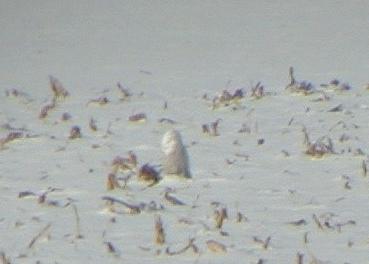
On 12 November 2000 both my kids and I went to Sodus Bay, Wayne Co., NY and found one distant Snowy Owl. Unfortunately, instead of perching on the nearby jetty where it would have made for decent photos, it was on the other side of the bay perched on someone's boathouse. It appeared fairly dark, but perhaps not distinguishable between a female and an immature male in this photo taken at 20x.
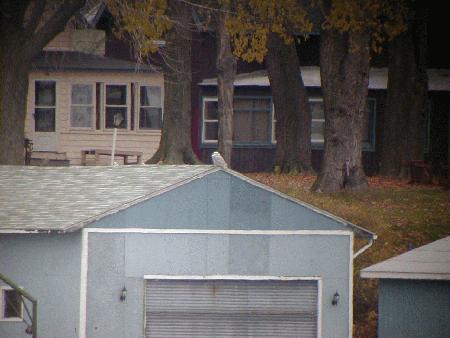
Unfortunately, not even the photo taken zoomed up to 60x allows for distinction from this angle.
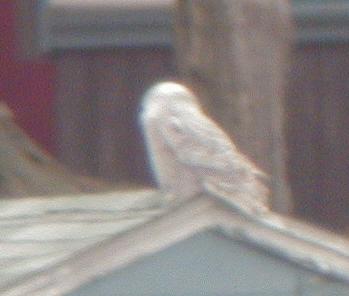
We moved around the bay but could never get close. We did manage to take some distant photos (at 60x) that at least showed the tail and back. I'd say female, based on tail bars (not sure if they're visible here; but they are on another viewer).
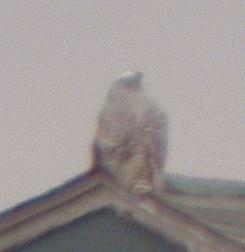
My final Snowy photo came also from the Savannah Mucklands, but on 3 January 1998 (and was taken with a conventional camera and a 300mm telephoto lens). It's hard to tell from the photo, but I remember the bird as well marked, but with fairly light markings, indicating a young male. I think the extensive bib shown in the photograph corroborates that.
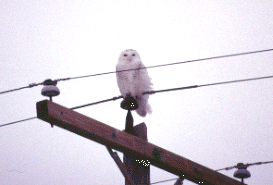
Return to the Bad Photos page.
Return to Kevin McGowan's home page.
Return to the Uses of a Collection page.
Return to Cornell University Museum of Vertebrates Ornithology Collection home page.
Go to the Crow Page.